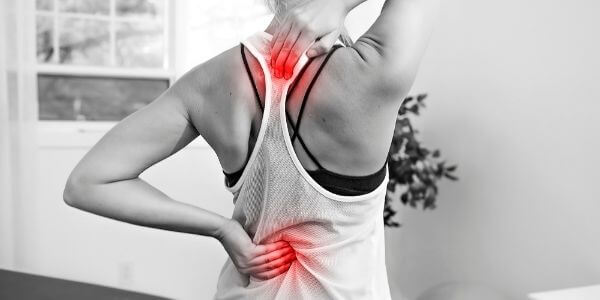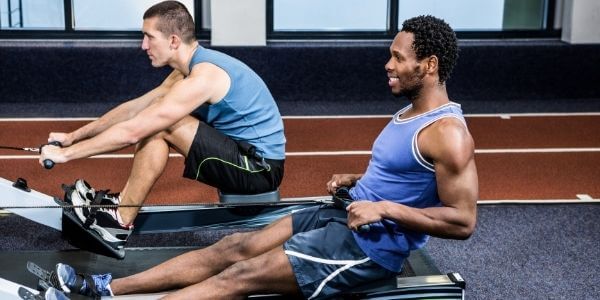Many physical trainers recommend rowing machines to clients with preexisting health problems. For example, if you can’t run on the treadmill because you have bad knees or don’t have enough coordination for the elliptical.
Besides, rowing offers a total body exercise that strengthens your muscles and improves your cardiovascular capacity. Most sources agree that rowing has a cornucopia of advantages and very few drawbacks.
Then there’s the back pain.
Back pain is the most poignant disadvantage of using a rower. Even healthy people have noticed some aches in their lumbar areas after using rowing machines. By contrast, people with chronic lumbar pain can’t even so much as look like a rower without immediately feeling a pang in their lower backs.
So what’s the deal with rowers: are they good or bad for your back? And how can you prevent back pain when you’re rowing?
Keep reading below to find out.
Table of Contents
Is a Rower Good for Your Back?
Rowing is a good exercise for your back because:
- It engages your lumbar area.
- It increases your back muscle strength.
- It improves your range of motion.
These are all factors that contribute to your back health. And more robust, more flexible muscles can prevent pain and decrease the risk of injury.
So why do people sometimes say they threw out their backs rowing?
We’ll dive into that within the following section:
Is Rowing Bad for Your Back?

The two most common types of back pain while rowing are:
- Lower back pain. Also known as lumbago, lower back pain from rowing feels like burning pain from your lumbar area to your buttocks. You’ll mostly feel this pain while finishing your stroke when you extend your legs. Usually, lumbago is caused by overworking yourself.
- Upper back pain. People who get hurt in their upper and middle back are primarily beginners who haven’t mastered proper posture yet. If you’re rounding your shoulders and tilting your head forward too much while rowing, you can damage your upper back.
Causes for Rowing-Associated Back Pain

Now that you know rowing-induced back pain is real let’s see how a rowing machine can damage your back. While we run through the most common causes and risk factors, we’ll also show you the solutions.
Overtraining
Overtraining means working harder and for longer than your fitness level currently allows. As a result, you can:
- Rupture your muscles.
- Pinch your sciatic nerves.
- Grind your discs.
Solution: Start with light workouts. Increase difficulty every 7-10 days, but change back to the easier exercise if you feel any pain.
Wrong Posture
Keeping the wrong form on the rowing machine means:
- Hunching your back so your lumbar area takes more pressure and strain
- Leaning back too much to get more out of your stroke
- Not fixing your rower properly
Solutions:
- Keep your core tight instead of crunching forward to alleviate the pressure from your lower back.
- Instead of tilting back too much, get more in the front while you’re beginning your rowing movement. This will give you a broader range of motion.
- Before starting your rowing machine workout, make all the necessary adjustments according to your body shape.
- If you’re using any devices while rowing, such as a tablet or smartphone, ensure they’re adjusted at the right height. You don’t want to sit in an unnatural position when using those devices.
How Do I Protect My Back While Rowing?

When you’re rowing, your back will have no choice but to:
- Curve outwards when you come up to row.
- Take all the pressure from your upper body when you’re tilting back at the end of your rowing motion.
This repeated curving and straightening of your lumbar area can rub your sciatic nerve and cause inflammation. It can also put extra pressure on your spine and even cause your lumbar discs to slip.
Don’t despair, though. The solution is to sit on the front side of your hips. As you tilt your hips forward, your back will remain in a neutral position from the beginning to the end of your stroking motion.
In Conclusion. Good Rowers against Back Pain
Rowing can strengthen your back muscles, but it can also cause back pain if you do not maintain a good posture or overtrain yourself. To solve that problem, you’ll want to adjust your rowing machine according to your shape, sit with your hips slightly tilted forward, and avoid hunching your shoulders.
Additionally, you should always choose fitness equipment according to your goals and preexisting health issues – that’s what we always argue in our articles.
So, how can you pick a practical rowing machine for back pain? Your rower needs to:
- Be highly adjustable to find the best posture for your body shape and needs.
- Offer a comfortable seat and handlebars so that you won’t feel compelled to strain your body in any way.
- Feature low resistance levels as well higher ones. Ideally, these levels are easy to adjust, with seamless increments that don’t force you to choose between a very light exercise and one that’s more than you can handle.
- 7 Exercises for Pregnant Women in the First Trimester: Safe and Effective - January 30, 2025
- Our equipment recommendations - October 30, 2024
- Here’s What Doing Cardio Every Day Does To Your Body - August 21, 2024

